1. Ladha K, Vidal Melo MF, McLean DJ, Wanderer JP, Grabitz SD, Kurth T, et al. Intraoperative protective mechanical ventilation and risk of postoperative respiratory complications: hospital based registry study. BMJ. 2015; 351:h3646. PMID:
26174419.

2. Cai H, Gong H, Zhang L, Wang Y, Tian Y. Effect of low tidal volume ventilation on atelectasis in patients during general anesthesia: a computed tomographic scan. J Clin Anesth. 2007; 19(2):125–129. PMID:
17379125.

3. Acosta CM, Maidana GA, Jacovitti D, Belaunzarán A, Cereceda S, Rae E, et al. Accuracy of transthoracic lung ultrasound for diagnosing anesthesia-induced atelectasis in children. Anesthesiology. 2014; 120(6):1370–1379. PMID:
24662376.

4. Gainsburg DM. Anesthetic concerns for robotic-assisted laparoscopic radical prostatectomy. Minerva Anestesiol. 2012; 78(5):596–604. PMID:
22415437.
5. Andersson LE, Bååth M, Thörne A, Aspelin P, Odeberg-Wernerman S. Effect of carbon dioxide pneumoperitoneum on development of atelectasis during anesthesia, examined by spiral computed tomography. Anesthesiology. 2005; 102(2):293–299. PMID:
15681942.

6. Restrepo RD, Braverman J. Current challenges in the recognition, prevention and treatment of perioperative pulmonary atelectasis. Expert Rev Respir Med. 2015; 9(1):97–107. PMID:
25541220.

7. Duggan M, Kavanagh BP, Warltier DC. Pulmonary atelectasis: a pathogenic perioperative entity. Anesthesiology. 2005; 102(4):838–854. PMID:
15791115.
8. Güldner A, Kiss T, Serpa Neto A, Hemmes SN, Canet J, Spieth PM, et al. Intraoperative protective mechanical ventilation for prevention of postoperative pulmonary complications: a comprehensive review of the role of tidal volume, positive end-expiratory pressure, and lung recruitment maneuvers. Anesthesiology. 2015; 123(3):692–713. PMID:
26120769.
9. Schick V, Dusse F, Eckardt R, Kerkhoff S, Commotio S, Hinkelbein J, et al. Comparison of volume-guaranteed or -targeted, pressure-controlled ventilation with volume-controlled ventilation during elective surgery: a systematic review and meta-analysis. J Clin Med. 2021; 10(6):1276. PMID:
33808607.

10. Choi EM, Na S, Choi SH, An J, Rha KH, Oh YJ. Comparison of volume-controlled and pressure-controlled ventilation in steep Trendelenburg position for robot-assisted laparoscopic radical prostatectomy. J Clin Anesth. 2011; 23(3):183–188. PMID:
21377341.

11. Lee JM, Lee SK, Rhim CC, Seo KH, Han M, Kim SY, et al. Comparison of volume-controlled, pressure-controlled, and pressure-controlled volume-guaranteed ventilation during robot-assisted laparoscopic gynecologic surgery in the Trendelenburg position. Int J Med Sci. 2020; 17(17):2728–2734. PMID:
33162800.

12. Assad OM, El Sayed AA, Khalil MA. Comparison of volume-controlled ventilation and pressure-controlled ventilation volume guaranteed during laparoscopic surgery in Trendelenburg position. J Clin Anesth. 2016; 34:55–61. PMID:
27687346.

13. Balick-Weber CC, Nicolas P, Hedreville-Montout M, Blanchet P, Stéphan F. Respiratory and haemodynamic effects of volume-controlled vs pressure-controlled ventilation during laparoscopy: a cross-over study with echocardiographic assessment. Br J Anaesth. 2007; 99(3):429–435. PMID:
17626027.

14. Park JH, Park IK, Choi SH, Eum D, Kim MS. Volume-controlled versus dual-controlled ventilation during robot-assisted laparoscopic prostatectomy with steep trendelenburg position: a randomized-controlled trial. J Clin Med. 2019; 8(12):E2032. PMID:
31766358.

15. Bouhemad B, Mongodi S, Via G, Rouquette I. Ultrasound for “lung monitoring” of ventilated patients. Anesthesiology. 2015; 122(2):437–447. PMID:
25501898.

16. Yu X, Zhai Z, Zhao Y, Zhu Z, Tong J, Yan J, et al. Performance of lung ultrasound in detecting peri-operative atelectasis after general anesthesia. Ultrasound Med Biol. 2016; 42(12):2775–2784. PMID:
27639431.

17. Monastesse A, Girard F, Massicotte N, Chartrand-Lefebvre C, Girard M. Lung ultrasonography for the assessment of perioperative atelectasis: a pilot feasibility study. Anesth Analg. 2017; 124(2):494–504. PMID:
27669555.
18. El-Khatib MF, Jamaleddine GW. A new oxygenation index for reflecting intrapulmonary shunting in patients undergoing open-heart surgery. Chest. 2004; 125(2):592–596. PMID:
14769743.

19. Volpicelli G, Elbarbary M, Blaivas M, Lichtenstein DA, Mathis G, Kirkpatrick AW, et al. International evidence-based recommendations for point-of-care lung ultrasound. Intensive Care Med. 2012; 38(4):577–591. PMID:
22392031.

20. Kim YS, Won YJ, Lee DK, Lim BG, Kim H, Lee IO, et al. Lung ultrasound score-based perioperative assessment of pressure-controlled ventilation-volume guaranteed or volume-controlled ventilation in geriatrics: a prospective randomized controlled trial. Clin Interv Aging. 2019; 14:1319–1329. PMID:
31409981.
21. Valenza F, Chevallard G, Fossali T, Salice V, Pizzocri M, Gattinoni L. Management of mechanical ventilation during laparoscopic surgery. Best Pract Res Clin Anaesthesiol. 2010; 24(2):227–241. PMID:
20608559.

22. Cinnella G, Grasso S, Spadaro S, Rauseo M, Mirabella L, Salatto P, et al. Effects of recruitment maneuver and positive end-expiratory pressure on respiratory mechanics and transpulmonary pressure during laparoscopic surgery. Anesthesiology. 2013; 118(1):114–122. PMID:
23196259.

23. Young CC, Harris EM, Vacchiano C, Bodnar S, Bukowy B, Elliott RR, et al. Lung-protective ventilation for the surgical patient: international expert panel-based consensus recommendations. Br J Anaesth. 2019; 123(6):898–913. PMID:
31587835.

24. Lian M, Zhao X, Wang H, Chen L, Li S. Respiratory dynamics and dead space to tidal volume ratio of volume-controlled versus pressure-controlled ventilation during prolonged gynecological laparoscopic surgery. Surg Endosc. 2017; 31(9):3605–3613. PMID:
28039643.

25. Toker MK, Altıparmak B, Uysal AI, Demirbilek SG. Comparison of pressure-controlled volume-guaranteed ventilation and volume-controlled ventilation in obese patients during gynecologic laparoscopic surgery in the Trendelenburg position. Braz J Anesthesiol. 2019; 69(6):553–560. PMID:
31836201.

26. Stewart TE, Meade MO, Cook DJ, Granton JT, Hodder RV, Lapinsky SE, et al. Evaluation of a ventilation strategy to prevent barotrauma in patients at high risk for acute respiratory distress syndrome. Pressure- and Volume-Limited Ventilation Strategy Group. N Engl J Med. 1998; 338(6):355–361. PMID:
9449728.
27. Jiang J, Li B, Kang N, Wu A, Yue Y. Pressure-controlled versus volume-controlled ventilation for surgical patients: a systematic review and meta-analysis. J Cardiothorac Vasc Anesth. 2016; 30(2):501–514. PMID:
26395394.

28. Ahn HJ, Park M, Kim JA, Yang M, Yoon S, Kim BR, et al. Driving pressure guided ventilation. Korean J Anesthesiol. 2020; 73(3):194–204. PMID:
32098009.

29. Rozé H, Lafargue M, Batoz H, Picat MQ, Perez P, Ouattara A, et al. Pressure-controlled ventilation and intrabronchial pressure during one-lung ventilation. Br J Anaesth. 2010; 105(3):377–381. PMID:
20554634.
30. Kim MS, Kim NY, Lee KY, Choi YD, Hong JH, Bai SJ. The impact of two different inspiratory to expiratory ratios (1:1 and 1:2) on respiratory mechanics and oxygenation during volume-controlled ventilation in robot-assisted laparoscopic radical prostatectomy: a randomized controlled trial. Can J Anaesth. 2015; 62(9):979–987. PMID:
25869025.

31. Marini JJ, Ravenscraft SA. Mean airway pressure: physiologic determinants and clinical importance--part 2: clinical implications. Crit Care Med. 1992; 20(11):1604–1616. PMID:
1424706.
32. Gargani L, Volpicelli G. How I do it: lung ultrasound. Cardiovasc Ultrasound. 2014; 12(1):25. PMID:
24993976.

33. Mongodi S, Bouhemad B, Orlando A, Stella A, Tavazzi G, Via G, et al. Modified lung ultrasound score for assessing and monitoring pulmonary aeration. Ultraschall Med. 2017; 38(5):530–537. PMID:
28291991.

34. Cho S, Oh HW, Choi MH, Lee HJ, Woo JH. Effects of intraoperative ventilation strategy on perioperative atelectasis assessed by lung ultrasonography in patients undergoing open abdominal surgery: a prospective randomized controlled study. J Korean Med Sci. 2020; 35(39):e327. PMID:
33045769.

35. Cadi P, Guenoun T, Journois D, Chevallier JM, Diehl JL, Safran D. Pressure-controlled ventilation improves oxygenation during laparoscopic obesity surgery compared with volume-controlled ventilation. Br J Anaesth. 2008; 100(5):709–716. PMID:
18407943.

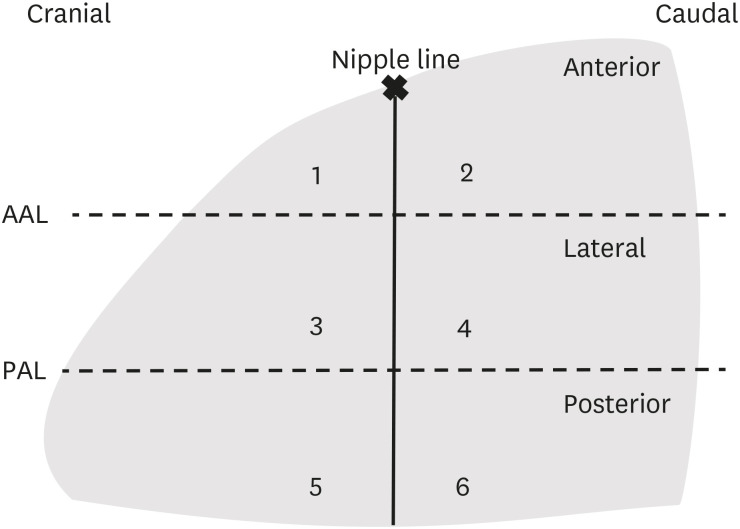



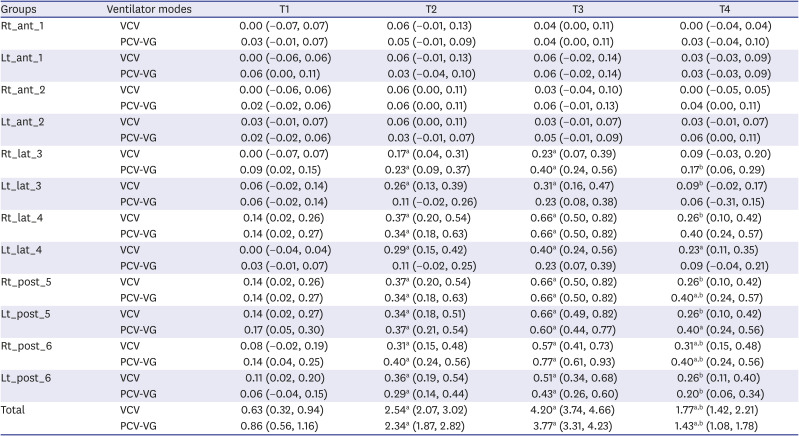
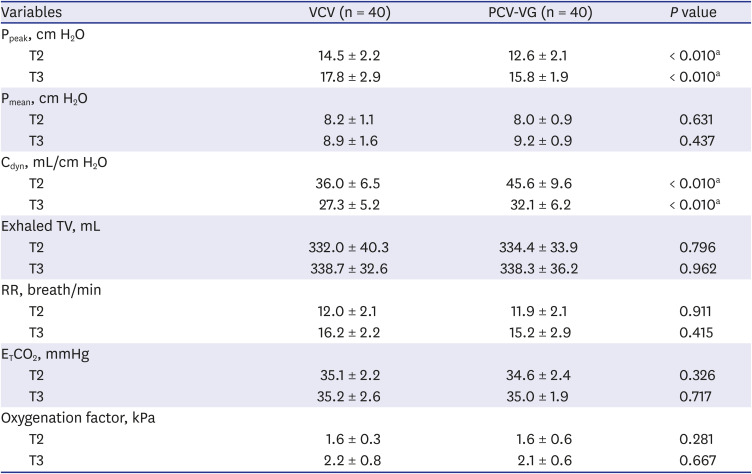
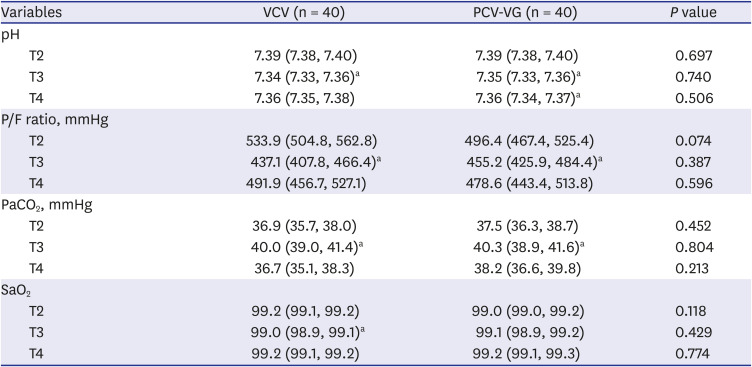




 PDF
PDF Citation
Citation Print
Print



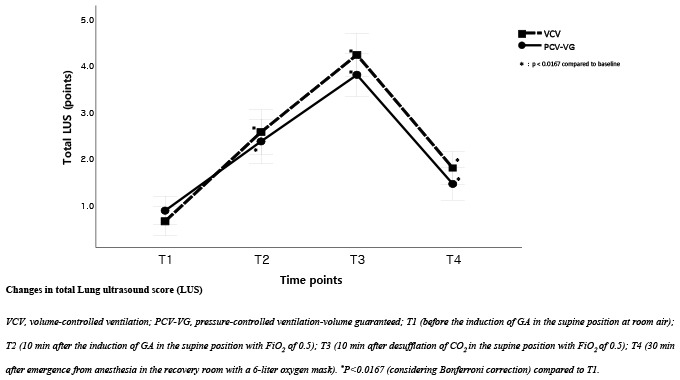
 XML Download
XML Download